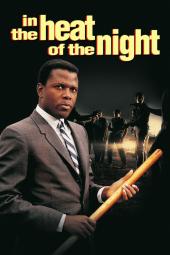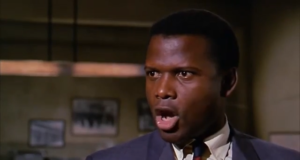Rating:
![]()
![]()
![]()
![]()
![]()

On a sweltering summer day in September, I wondered what would be my first movie review. I have quite the collection of movies to choose from and yet was stumped on the one to review. I could’ve gone with my favorites: Ghostbusters, Jurassic Park and Teenage Mutant Ninja Turtles. The obvious choice would’ve been Teenage Mutant Ninja Turtles but let’s be unconventional here. With October right around the corner, I could’ve written about some type of horror film. Hell, I could’ve written about some movie about going back to school, since it’s that time of year. BLAH!!! Yet, I wondered what video to review while sweating more sweat than I care for along with blasting the little air conditioning that I have in my apartment, I stopped upon In the Heat of the Night. The title was appropriate for this time of year, but the intrigue of watching this film again caught my eye. You personally can’t go wrong with this Sidney Poitier movie along with being a murder mystery.
Seeing Sidney Poitier act and say that powerful line, made you want to stand up and say, “That’s right fool. They call me…..” In the Heat of the Night is a CLASSIC movie that everyone should watch for its powerful performances from the two main stars but also on the topics of racial divide and tension. The film was nominated for seven Academy Awards while winning five of them with the prominent ones being Best Picture and Best Actor of Rod Steiger.
As the opening credits of rolled on the scene, Ray Charles rhythm and blues, and gospel singing voice blared with that ole southern vibe, it brought goosebumps to my skin. I closed my eyes as the rhythm of the song played. As I listened to the music, it made me remember my time growing up South Carolina: the long southern drawls of my words, the blistering heat with humidity that made you all sweaty, saying y’all to everyone while fishing and having that good ole southern cooking. As I watched this compelling and intriguing movie, several things ran through my head: “The more things change, the more they stay the same.” Many of the issues and problems that arise from this movie are still prevalent today in 2019. Racial tension is still high, racial discrimination and profiling are even talked about today, and the list goes on as it is significantly displayed in this film. What this film does for its time is put two people from entirely different backgrounds, worlds, and ideas and forces them to work together and set aside difference.
Directed by Norman Jewison with a screenplay from Stirling Silliphant that was based on John Ball’s novel of the same name, Jewison presents an intense, murder mystery that finely shows the racial divide, tension, and conflict between two people that are forced to work together. On a hot September night in Sparta, Mississippi, the body of wealthy northern industrialist owner is found murdered in the alley. While waiting for his next train and minding his own business while reading a newspaper, African-American Philadelphia police detective Virgil Tibbs (Sidney Poitier) is arrested on suspicion of murder by Bill Gillespie (Rod Steiger), the racist police chief. Tibbs proves his innocence and identity by having to call his own boss and straightening things out. While trying to leave the small little southern town, Police Chief Gillespie “traps” Tibbs by learning he is the Philadelphia PD’s number one homicide expert. With his supervisor on his back, Tibbs reluctantly gives his assistance to track down the real killer. As Tibbs begins his investigation, he gets caught up in the racial tension directed towards him on every social level in the town while making enemies with everyone as he quickly hunts for the truth.
What stands out most in this movie is the performances of Sidney Poitier and Rod Steiger. Poitier’s performance as Virgil Tibbs is quite frankly exceptional. Poitier’s portrayal as Tibbs is one that shows how cool and in control, he is over his craft and character. A performance that lifts the film but shows a demeanor that is just too cool. He receives racism from all sides while showing subtle flaws of the character to make you really root for him. Poitier plays Virgil as a man that has high standards of himself and the career he has. His mannerisms are those that project not wealth but professionalism, yet Poitier shows that through all the calm demeanor of a man from the North, the fear of being in the South is extreme in his mind and brings out the flaws of Virgil. That the past still haunts this strong character while wanting to escape the real world, he must be in for the time being. Poitier makes Virgil so relaxed and calm with sayings like “Ya Dig” along with his smarts that you simply cannot root for this character. Yet, how doesn’t Sidney get nominated for an Academy Award?
On the opposite end of the spectrum, in terms of character to Virgil, is Steiger’s performance as the diehard Dixie racist cop Gillespie. Steiger should be and was commended and praised for this performance winning the Academy Award for Best Actor. Steiger transforms into his role as the police chief Gillespie. You think Steiger is actually playing himself with that long drawn Southern accent, really hard and fast gum chewing, the hard-ass police chief. Gillespie tries to show his authority by always saying boy to anyone, doesn’t put up with anyone’s foolishness, but is flawed by thinking everything is clear cut rather than asking for help from people he thinks is beneath him. Yet his transformation in the film is one to be commended. To go from one view to genuinely having some respect for a character not based on their color but their skills are great to watch.
The script/screenplay is phenomenal and resonates with times today when dealing with racisms but also having a great storyline where two people from literally opposite sides of the track are forced to work together. One being alone, intelligent and strategic homicide detective from the North while the other is a racist, shrewd fast-talking, loud mouth Southern sheriff. Quite a pair they make. The topic of racism with racial tension is developed high in this movie that centers on a murder and forces a very odd couple together. You wonder if the two main characters can actually put aside their differences and figure it out. In an almost all-white town, the first instance of racism that presented is racial profiling. As one of the cop’s searches for the killer, he spots Tibbs in the train station, reading a newspaper. The police immediately assume that Tibbs is the killer without asking for identification or questioning. Just tells my man to get in the back. If he were the killer, he would be gone. Even as Tibbs gets to the police station, Gillespie always says boy until they figure out that Tibbs is a Philadelphia police detective and the number one detective. With this knowledge, along with asking for help, you see that the police chief is still reluctant.

via: MGM Studios
As the story progresses, the racial tension of the environment stays high as Tibbs encounters racism from all sides but what is most potent is he commands the respect that he deserves while getting the backing from the victim’s wife. Jewison expertly and gracefully shows this as Tibbs finishes his autopsy and states to Gillespie and his staff that the person, they arrested is not the one who did it. Gillespie not satisfied with being outsmarted or questioned sets up a scene that expertly displays how Tibbs is not taking any mess from anyone. As Gillespie gets in the face of Tibbs and berates him, Gillespie yells, “Virgil”? That’s a funny name for a n***er boy to come from Philadelphia. What do they call you up there?” to which Virgil responses with the iconic “They call me MISTER TIBBS!!” Truly an iconic moment of when a black man stands up for himself to racism and makes it even more profound when Jewison shows only Virgil and the anger in his face.
Another scene that is truly powerful and made you just go, “Oh Damn!” was when Tibbs and Gillespie go and question the wealthy Endicott. Endicott looks like a plantation owner and has the mentality of one. He has a cotton field with nothing but black employees. Might as well write slave master on the front sign. Endicott and Tibbs talk about orchids, and when Endicott states that the orchid is like the Negro as they need feeding and care, which takes time. Endicott soon realizes that he was being questioned and becomes very upset. As Tibbs examines Endicott, Endicott slowly walks over to Tibbs and backhands the man. On a rating scale of 1-5 for the backhand, it receives a 2.5. It was quick. I threw up my hands and said, “Oh Hell No!” BUT Tibbs without hesitation or a second thought backhands the taste out of that old white man and makes him fall over. A rating scale of a 4.5 for that slap. Gillespie’s face says it all as he is in total shock and doesn’t know what he saw or to do. Once again, the man got the taste slapped out of him.
In the Heat of the Night is a classic film that shows what happens when race and culture collide all of a sudden. When two parties don’t want anything to do with each other but must help each other out. The relationship and progression of Poitier and Steiger characters are done so well that it makes this very movie. From starting out as enemies to finally having just respect for each other goes a long way. No matter how many years pass, this movie will still resonate with the culture and times.